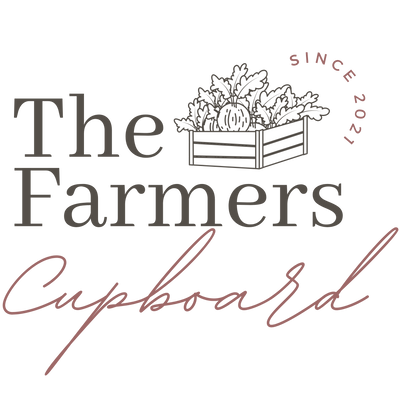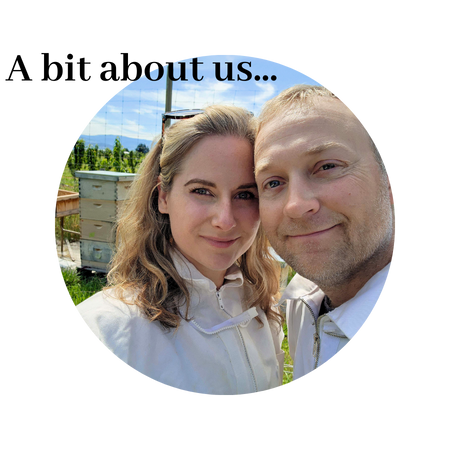Beekeeping is an exciting and fun hobby, and there is so much to learn. There are so many reasons why people keep bees, and you may want to do it to keep and store honey, or perhaps you want to get beeswax to make raw beeswax candles, beeswax wraps and other natural products.
We love keeping bees for the above 2 reasons, but also because it is an extremely interesting hobby that connects you to nature. Plus, checking in on your bees and doing hive inspections is relaxing and enjoyable.
If you are thinking of starting beekeeping, we are going to cover all of your beekeeping equipment needs. This is a great place to learn about beekeeping equipment as we may cover things you never thought of.
What do you need for beekeeping equipment?
The beekeeping equipment you need when starting beekeeping includes:
- the hives and hive components
- hive tools
- beekeeping clothing to protect yourself
- a bee smoker
- the bees themselves
This is a very basic list, so we will go into some more details about which beekeeping equipment you need, especially when starting with beekeeping. From there, you will learn more about beekeeping equipment and decide on the items you don't necessarily, but the ones you want that may make your beekeeping life easier.
See some of these items in our Gift Ideas For Beekeepers article, there are some great tools in there.

Beekeeping Equipment List | Supplies Needed For Beekeeping
Check price of all beekeeping supplies here
Beekeeping equipment can be divided into 3 basic categories:
- The hive (hive body)
- Beekeeping tools (beekeeping supplies)
- The bees (worker bees, drone bees and the Queen bee)
We will talk about each point below, starting with the hive and what you need to start your own and this is the place many beekeepers start their beekeeping journey.
The Hive
Your honey bees will need a home to live and work in. This is called the beehive or the hive body. Modern beekeepers tend to use use the standard Langstroth hive.
Your choice of hive bodies are matter of personal preference, but it is one of the most common beehive designs and is very easy to get to know and understand the components of, plus, they are more easily available.
The Langstroth Hive
The Langstroth hive arrangement was invented in the 1800's by Lorenzo Langstroth and is designed to make the management of the honey bee colony as quick and easy as possible for the beekeeper while taking advantage of the honey bee's natural behavior.
There are a number of components and hive parts to this hive body including:
- bottom brood nest or brood chamber
- queen excluder
- hive stand
- plastic foundation
- brood combs
- various hive bodies
There are MANY variations of hive bodies and hive parts of the Langstroth hive with features that can make management such as feeding, winterizing and general inspections easier.
It is easy for learning, stacking two hives bodies onto (or more) and can be used in natural beekeeping if you allow the bees to make their own natural wax frames without a base.
Beekeeping Hive Kit
You can purchase the full Langstroth Hive as a kit, and it includes a wax-coated sold bottom board, a top cover, an inner cover, a Queen excluder and an entrance reducer.
This is a really great way to get everything you need in a bee hive in one kit. This one has amazing reviews, is high quality and is made from Fir so it won't warp (like a pine one might) and it will come right to your door.
Check price of a 10 Frame Langstroth Beehive here

This all being said, here is what each component does: the Langstroth hive body has the following main components:
1. A Beehive Top Cover
The beehive top cover is basically the lid that covers the top of the hive bodies. You can get as fancy or as simple as you would like to with this part of the beehive. The bees usually do not interact with this part of the hive, other than occasionally landing on it.
It is suggested you stay away from anything that is not a flat top. The reason I follow this rule is because when I am doing hive inspections, I place the top cover on the ground or the hive next door, and then use it to place the hive boxes onto.
So I use the top cover as a table and this would be difficult to use as such if it were slanted or peaked. I put my own personal hive tools on the top cover of the hive next door to the one I'm working on, it's just convenient.
If you have a fancy sloped top cover for a hive (some beekeepers like to make them look like little houses) then you can't use the top cover for this purpose.
2. A Beehive Inner Cover
The beehive inner cover serves a couple of important functions:
-
First, the beehive inner cover is the actual ceiling inside the hive bodies. That is, if you were a bee in the hive and you looked up, you would see the inner cover. It keeps the honey bees confined to the hive boxes.
-
The inside cover of the beehive is also a handy place to put your bee food, nectar or pollen substitute. My top covers have 3-inch holes drilled into them that allow the bees to access the food when there is little to no nectar flow.
-
The inner covers can also have a hole in the edge to allow the bees to have another hive entrance. In places with cold winters, the inner cover can also be used to place a moisture absorbent material to control condensation.

3. The Beehive Boxes: Bottom Box And Top Boxes
The hive boxes of bee hives are where all the magic happens. Beehive boxes are where your honey and brood frames hang, and where the honey bees spend their time when they are not out foraging. Your beehive will come with bottom boxes and top boxes, and these are very different, and we will talk about each below.
Let's talk a bit about the bee hives design first: they are each designed with "bee space" in mind, and it is good to first know what your "bee space" is.
What is the bee space?
The bee space is a special distance that allows the bees to maneuver around, but isn't so spacious that they start to build comb in places the beekeeper doesn't want them to (like in between the frames and the box sides). If that happens, the experienced beekeeper will have to cut that comb away to get the frames out for inspection with the proper equipment.
What is the correct measurement of a bee space?
3/8" is the exact standard measurement of a proper bee space.
The boxes and the frames of a Langstroth hive comes in two standard sizes: medium and deep.
What are the top and bottom boxes for on a beehive?
The Bottom Box
The first box (the one at the bottom of the stack) is called "the brood box".
Check price of a brood box with wax-dipper wooden frames here
This is where the brood nest is and the brood combs in the hive bodies. In bee hives, this is normally a deep box and it's where the queen generally lays all the eggs, or her "brood". On top of this many experienced beekeepers prefer to place a queen excluder.

The Top Boxes A.K.A "The Supers"
Check price of medium super box on Amazon here
The second box, placed on top of the brood box, and subsequent boxes above that one, are called "honey supers" and as the name implies, it's where the bees store honey.
This is where you will collect your honey harvest from! So when you see those really tall beehives in a farmers field, you know they have one brood box on the bottom and the rest are all honey supers above it.
4. Beehive Frames
The beehive frames are just like a picture frame but instead of holding a picture inside, they are holding "foundation". This is what your bees will build honeycomb on.
What is the foundation of a beehive frame?
The plastic foundation in a beehive frame is a food-grade plastic sheet that has the imprint of honeycomb on the surface. The honey bees instinctively start to build beautiful wax comb onto this surface following the pattern.
5. Beehive Bottom Board
The beehive bottom board is the floor of the beehive and sits just below the brood nest and on top of the hive stand. If you are a honey bee and are going about your business inside the hive and look down, you see the bottom board.
This bottom board in a beehive has a few design variations, however these days the modern beekeeper is usually using a screened bottom board. This basically means that the floor of the hive is a screen that allows debris and mites to fall through while providing some ventilation.
The bottom board of a beehive also has the main hive entrance and usually some ability to reduce the entrance size.
The bottom board normally sits elevated off the ground on a wood support structure so it is not in contact with wet soil or grass where it may rot or attract unwanted pests.
Beekeeping Tools
There are a number of tools needed for beekeeping and the tools you need for beekeeping depends on the size of your beekeeping operation.
Here are the essential beekeeping tools, but please note that this list does not include any honey harvesting tools, which you will not need for the first year anyway.
By the way, if you are able to harvest honey in your first year (when your bees have surplus honey), congratulations! It is possible. And, you can use the tools you have on hand in your kitchen since you likely won't have very much honey this first time in terms of surplus honey.
Honey harvesting tools are something you do not have to buy when purchasing your beginning beekeeping equipment, so you have some time to research and think about them. Remember to keep us in mind, bookmark this website to come back to learn more!
Here is what you do need right away for beginner beekeeping tools:
1. A Hive Tool For Beekeeping: A Standard Hive Tool or A J Hook
Standard Hive Tool: Check Price Here
Your hive tool is definitely the most used tool for the beekeeper. This handy, metal hive hand tool is used for scraping away unwanted burr comb, removing queen cells, removing propolis, and the list goes on from there.
The most frequent use for your hive tool will be for opening the beehive and lifting those 'glued-in' frames. The hive tool comes in a couple of variations with the most popular being the standard hive tool and the J hook. You can get a standard hive tool and a J hook to have in your beekeeping arsenal.
2. A Beekeeping Smoker
A smoker is a beekeeping tool that is used to calm the honey bees. It creates smoke by burning a substance inside and channels it through the smoke hole by pushing wind into it. The smoke is directed onto the bees by your direction when you push the air through.
The smoker is one of the tools that has a special place in the beekeeper's heart. For many beekeepers, there is a meditative component to the smoker. For us, the act of lighting the smoker and the smell of the smoke is a ritual that goes back 3 generations in our family.
That smoke smell is very nostalgic and has a calming effect on the bees, which is instantly noticeable. As for smoker fuel, I use shredded paper from my office or hay from the barn, but you can purchase bee smoker fuel on Amazon for a longer lasting burn.
3. A Beekeepers Bee Suit
A bee suit is a must-have piece of beekeeping equipment for obvious reasons. Beekeepers try to breed bees to be gentle and tolerant of the beekeeper invading their space, however, the bees will still probably get defensive towards the end of the summer when their hive is full of the honey they worked hard to create.
4. Beekeeping Gloves
Just like the suit, beekeeping gloves are another necessity. You've probably watched YouTube videos showing the seasoned beekeeper bare handing the frames; with their gentle worker bees crawling all over his bare skin with no concern.
It can be like that and it often is, BUT when your hive is grumpy or defensive because it's raining, or it is too late in the day, or there is no nectar to forage or for any number of reasons, you will wish you had a pair of protective beekeeping gloves.
Although it may be easier to bare hand a frame, beekeepers prefer gloves when the bees are acting protective or angry.
5. A Beekeeping Bee Brush
Sometimes you need to move bees around. This may be because you need to get them off of a frame you are harvesting or because they are in the way when you are putting the hive back together after your inspection.
Whatever the reason is for your opening of your hives, you don't want to harm your bees so a gentle brush is the best way to go.
The Bees
So you've put your hard-earned cash down and have your hive and necessary beekeeping tools. Now it’s time to purchase your bees.
The best way to go about purchasing bees is to search your local area for a local beekeeper. Your local beekeepers will be able to provide the best nuc (pronounced "nuke") colonies or bee packages for your area.
Ask people in your local bee club or social media groups for reputable bee breeders. Asking for recommendations locally is a fantastic place to start.
Once you have found a bee breeder, ask them what characteristics they breed bees for. Honey bee characteristics may include:
- honey production
- cold hardiness
- gentleness
- resistance to diseases
- hygiene
- resistance to mites
- or more
Some bee breeders even breed for a particular color of bee!
Make sure you place your bee order in late winter. That will ensure your supplier isn’t sold out (yes, this happens everywhere, if you wait too late in the year you will not get bees that year).
Here are some other articles you may be interested in reading:
Pros and Cons for Beeswax Wraps
Candle Making Supplies | ARTICLE
How To Use Beeswax To Polish Furniture
Did you like this article?
❤️ Here's how you can support our blog:
My name is Linnea and I am a backyard gardening enthusiast! Along with my husband and our two kids (and chickens, ducks, honey bees and our little dog). Our hobby - growing our own food and making our meals from scratch. My blog, The Farmers Cupboard, is the website that blossomed from that passion. I love every second I spend sharing our hobby with like minded backyard growers.
It's easy to support my blog, and it is so appreciated. Please SHARE an article somewhere, pin a photo to your Pinterest board, follow on any of our social medias or sign up for our newsletter! That's it!
These little things help our blog grow and allow us to continue doing what we love: growing good food and sharing what we learn.
PINTEREST PASSIONATE? We're opening up our cupboard to you!
Click on the pin below made just for you. It will bring you right to my little Pinterest community, where I would love for you to FOLLOW The Farmers Cupboard and see all of our gardening and backyard dream ideas!
Let's grow good things together!






















I very thank you for your information
yay bees – hoping to start my own little colony. will be checking in with you for tips. hope all is well.